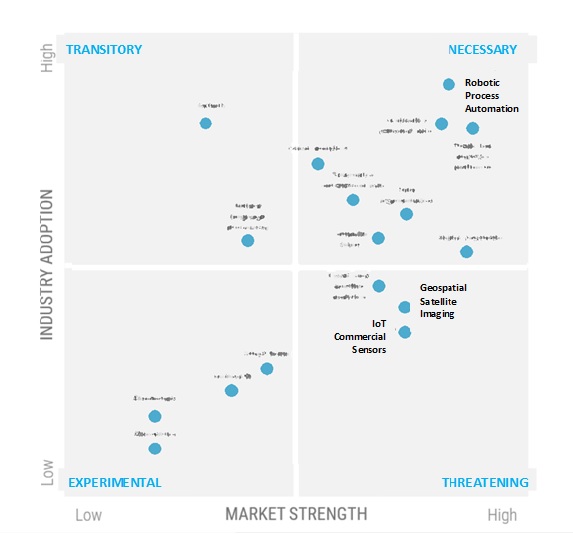What’s NExTT?
It’s a question that CB Insights analysts asked—and answered—in a recent report about trends in property/casualty insurance technology, finding that eight of the 17 emerging technologies analyzed are now “necessary” for P/C carriers.
The acronym “NExTT” refers to a framework that CB Insights uses to track whether technologies are necessary, experimental, threatening or transitory by looking at a combination of adoption levels (measured by looking at startup momentum, media attention and customer adoption, among other data) and market strength signals (the number and quality of investors, earnings call commentary, and deal-making activity, for example).
“There are a lot of these technologies that are fast on their way to becoming just table stakes,” said Mike Fitzgerald, principal analyst, Insurance for CB Insights, referring to technologies like robotic process automation, predictive analytics platforms and data augmentation technology. Those three are among the eight categorized as “necessary” by Fitzgerald and his research partner, Niall Williams.
A graphic in the report shows 17 dots, each representing a different technology, arrayed in quadrants. With market strength plotted on the x-axis (from low to high going left to right) and industry adoption on the y-axis (from low to high going from bottom to top), necessary technology falls in the upper right given their high strength and high adoption levels. In the quadrant below, representing low adoption by high market strength are the “threatening technologies”—including geospatial satellite imaging and commercial sensors.
Why 17?
According to Fitzgerald, he and Williams didn’t rely solely on the data that CB Insights gathers from thousands of Internet sites and data sources to select the 17 technologies highlighted in the report, “P&C Insurance Trends To Watch In 2020: Digitization & Task Automation.” They also factored in information gleaned from conversations with industry executives. And in a departure from past analysis, the two men restricted their focus to technologies that are digitizing processes or automating tasks.
Even with that focus, there were more technologies that the two researchers could have bucketed in the transitory category. “Once we got up to 15 and 17, we needed to cut it off…But what [the chart] really communicates, [regardless of whether] there are 17 or 15 or 12, is that items are moving in the upper right,” he said. It “verifies how important technology is becoming in P/C insurance, particularly when you look at how to make processes more digital or you automate tasks,” Fitzgerald said, noting that the necessary category is more cluttered than even just two or three years ago. “That shift to the upper right is a real good signal of what’s going on in insurance technology in P/C insurance,” he said.Asked whether COVID pushed the change in 2020, Fitzgerald highlighted digital payments technology as one example of a COVID-driven shift to the necessary category. Ranked lowest in terms of market adoption among the eight technologies classified as necessary, the report notes more than half of all insurance disbursements are still paid by paper check in the U.S. compared to 22 percent outside of insurance. “There hasn’t been the overwhelming client demand in the past, but the pandemic sure has changed that,” Fitzgerald said. “People are much more expectant of receiving payment instantly—and receiving directly,” he said, also noting that it doesn’t make sense for insurers to offer great digital interactions on the front end and then tell customers that “the check is in the mail” on the back end.
Necessary Technologies: RPA, Predictive Analytics, Data Augmentation
Fitzgerald answered some questions about other necessary technologies and several the report characterizes as threatening.
Q: RPA has the highest adoption and market strength, and CB Insights analysts’ consensus put the worth of the RPA technology sector at $8 billion in the coming years. How should carriers go about finding the RPA vendors with insurance expertise?
Fitzgerald: What they can do, and I found myself doing, is looking at the marketing materials of the big vendors, their websites, their communications, their PR, the news signals that are out there on the platform and finding out which ones actually mention insurance…It’s a smaller number than that wide universe of $8 billion, but within that small number, they seem to have a very broad insurance application. Most of them are operating in multiple areas in the insurance function. Claims is a great place for RPA vendors to start, but also policy submissions—managing that and taking some of the manual processes out of that is another one that is often a target.
(Editor’s Note: During a September webinar titled “What Tech Offers: The Future of P&C Underwriting,” Fitzgerald and Ted Stuckey, chief growth officer of Arrowhead Insurance Group, also offered the possibility of searching patent data for RPA companies to find those with unique patents for underwriting applications.)
Q: CB Insights analysts routinely try to predict whether an emerging technology will be overrated or underrated in five years. What’s your assessment for RPA?
Fitzgerald: RPA has got some runway yet, but it’s really going to work itself out of a job, if you think about it. A lot of the work that’s done by RPA is going to end up being done by the next version of technology, which has to do with taking workflow engines and putting it together with predictive analytics. And so, I would be very surprised in that three- to five-year time frame, if we don’t see a ramp-down of the application of RPA just because there’ll be other and better tools.
Q: Are you surprised that carrier adoption of predictive analytics ranks lower than RPA?
Fitzgerald: It’s a little bit lower. Moving predictive analytics beyond pricing can be difficult for insurers because it’s so heavily reliant on good data sources. So, many insurers that have gone on the data cleanup journey, and the data administration, and the data management and data governance journey, are still on that journey. And even more haven’t invested in that.
Until you invest in that, predictive analytics can only be implemented so far, because when you’re predicting on bad data, you’ll get bad predictions. So, there are more dependencies on making predictive analytics work beyond pricing, which is initial implementation for many companies. Pricing still has data issues, but that’s in a more contained environment. There’s a smaller group of folks that work on the models. So, that’s been able to move ahead. But when you start using predictive analytics for things like decisioning or recommendations to underwriters, you’re bringing in a lot more data and a lot of different data sources. It becomes infinitely more complex to implement.
Q: Data augmentation is also in the necessary bucket. Who are some providers and what do they do?
Fitzgerald: This is really exciting to me because I [remember] the times when I worked in insurance technology on underwriting issues [and would hear], ‘This is what we got from the agent,’ or ‘This is what the applicant gave to the agent,’ or ‘This is what came back from this other data source and it doesn’t match up with this other,’ or ‘Something else is missing…’ It’s really hard to make progress when you’re just trying to get kind of the basic facts right…With data augmentation, insurers have so many more sources they can go to to either confirm what they’ve been told or not even ask.
The Holy Grail here is the two-question insurance application: No. 1, what’s your legal name or what’s the legal name of your business? And 2, what’s your address? And then go out and get everything else from other sources. That’s really what data augmentation is about…
One of the companies that we profiled in the past has been Carpe Data. They have specialized in going out to [websites] like social media sites and bringing back the data that they could for that. There’s also a company that used to be called DataCubes, now called Convr. They go out to more traditional underwriting data sources, but typically not the ones that an insurer might be using, and they bring them in.
Where this really becomes so powerful is in being able to match that and marry that with predictive analytics, so that now, you have a predictive platform that’s working on objective data, from more data and more dimensions of data, in order to give a recommendation for a decision or maybe even [make] a decision depending on how someone draws up what they want that to look like. The computer doesn’t have to make a decision, but it can certainly make a recommendation. It can make a prediction, and it can make that based on a lot more data sources or a lot cleaner data because it’s been sourced from different places and then analyzed and crossed with what you may have gotten during a typical applications process. It has the potential for radically changing the way that we typically collect and then act upon insurance data.
Threatening: Geospatial Satellite Imaging and Commercial IoT
 Q: The report describes a few technologies as threatening—characterized by high market strength but low adoption. One of them is geospatial satellite imaging. What’s happening with that?
Q: The report describes a few technologies as threatening—characterized by high market strength but low adoption. One of them is geospatial satellite imaging. What’s happening with that?
Fitzgerald: By 2025, the capabilities we have now are going to grow exponentially…If there are 100 satellites going around the globe right now, feeding our GPS signals and our Google maps and all of the things that we rely on now, then in another five years, there are going to be 10,000. These numbers aren’t exact, but it’s that order of magnitude. [And] these aren’t space station-sized satellites. They’re very small—the size of a suitcase or a countertop microwave oven. So, the idea that we could have that many around the Earth…It’s physically possible…It’s so hard to get your head wrapped around that, [but] that’s where it’s going.
That is so much more powerful than what we have now—say, an underwriter sitting at his or her desk scanning photos. Certainly being able to capture that data and have it in a digital form so you can always refer back to it and get trend lines over time—not from one or five or 20 accounts but from literally thousands of accounts that have a very detailed digital footprint that you can then analyze and draw meaning out of. It’s extremely exciting, and it’s going to be a step change in terms [of what carriers] can do certainly on underwriting and also on risk control…
A lot of [carrier use cases] have to do with large commercial risks…These [risks exist] either over a wide area or they have a number of pieces of equipment or building that are being assessed for underwriting inspection or underwriting evaluation. Or if there’s a claim and it’s actually being settled.
The best application for this is in the larger type of accounts—[and] that’s an area [that] the other technologies in play in P/C insurance haven’t really touched yet. But geospatial has the potential to really bring new and different value to that larger account segment.
Q: How are carriers using another threatening technology—commercial sensors and the Internet of Things?
Fitzgerald: The different sensors that we can, and do, put on machines or goods in transit or buildings—thermostats, smoke detectors—are all throwing off data. Then you can take that data and interpret it and get meaning out of it, decide whether there’s an action that needs to be taken.
The best and most evolved application [I have found] is AXA XL’s construction ecosystem. It involves technology that goes beyond just sensors, but sensors plays a real key role [in] really proactive risk management. Instead of risk management being reactive or after the fact or partial, or a point in time [when] there’s a risk engineer who goes out to a site and looks at something, this is making it much more continuous and much more real time. [It involves] activities like being able to tell from a photo that a pallet of material has been left in a traffic zone [of a] construction site. Using simple camera technology, you can tell if something’s in the wrong place, if it’s a possible slip-and-fall hazard. Previously, this was mitigated by either security guards doing their rounds or by risk managers or by supervisor training and saying, ‘Look out for this or that.’ Now, with IoT and the cameras, you can actually identify those and signal them without anyone having to notice them and react to them.
The challenge is you have all of these cameras around and all of these signals coming in. How do you make sense of them? And the type of thing that AXA XL’s ecosystem tries to do is to not only take the signals that are out there, but actually get meaning from them and then put that against a risk management context and decide whether or not there’s a potential hazard there that might need to be mitigated before there’s even a loss.
People buy insurance to indemnify them from a loss, but they also buy insurance, particularly in commercial lines, in order to avoid a loss all together. And commercial IoT has a huge opportunity to help with making that risk management be more risk avoidance than reactive and more real-time and more continuous…Every six months that goes by brings new opportunity and new capabilities. And we’re just going to see this continue…It will be up in the necessary phase very, very quickly.
(Editor’s Note: Gary Kaplan, president of North America Construction at AXA XL, wrote an exclusive article describing the development of AXA XL’s Construction Ecosystem earlier this year, “From ‘Blue Sky’ Thinking to Groundbreaking Risk Initiatives“)





















 Northern California Flooding This Weekend Caused by Heavy Rain, High Tides
Northern California Flooding This Weekend Caused by Heavy Rain, High Tides  Surge of Supercharged Hurricanes Prompt Call for Cat 6 Classification
Surge of Supercharged Hurricanes Prompt Call for Cat 6 Classification  Good Times for U.S. P/C Insurers May Not Last; Auto Challenges Ahead
Good Times for U.S. P/C Insurers May Not Last; Auto Challenges Ahead  How Insurers Can Avoid Post-Merger Technology Failure
How Insurers Can Avoid Post-Merger Technology Failure 






